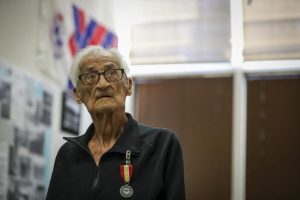Chief Warrant Officer Wayne Griffin has spent 5-1/2 years of his decade-long career as an Army pilot based in Hawaii. The mountains, valleys and the long stretches of blue ocean between the islands serve up some of the most beautiful views a pilot can see — but they come with unique challenges, too.
“Flying here can be extremely varied,” he said. “You could start your day out with the sky being clear. And then, depending on the winds and weather, since we’re so far out in the middle of the ocean, things can dynamically change with the mountain structure that we have on the islands. So you could go from real nice weather to very heavy rain.”
The military considers Hawaii an increasingly critical training ground and operational hub as tensions simmer in the Pacific. With its varied terrain and microclimates, the Army has been touting training ranges in the islands as ideal places to train soldiers in terrain similar to the areas they may be called to operate in.
As the Army looks to reorient its operations in the region, aviation is playing an increasingly central role — and the Army’s 25th Combat Aviation Brigade at Wheeler Army Airfield is leading the charge. Through the Army’s Operation Pathways — which sends U.S. troops to countries around the region and brings foreign troops to American bases to train — the brigade has helicopters deploying to multiple countries every year.
This year they participated in exercises Cobra Gold in Thailand and Balikatan in the Philippines nearly back to back, with more planned.
“A lot of this combat power that we’re building here on Oahu is so that the aircraft can go forward where there’s a very austere and immature footprint (where) we don’t have the hangars and all the parts and pieces that we have back here to sustain our fleet,” said Brigade commander Col. Rob Bryant. “They’re doing all of that forward in an austere environment over the Pathways rotation.”
During Balikatan, Army and Marine Corps helicopters ferried American and Philippine troops from U.S. Navy ships as they landed them on islands in the Luzon strait, just south of Taiwan.
The Marines have also been reorienting their operations in the region and are radically reshaping their force, including significant changes to its aircraft inventory in Hawaii as it seeks to return to its roots as a naval fighting force. But Bryant said he sees the future of Army aviation focusing on land operations in the Pacific supporting U.S. and allied troops that could find themselves operating anywhere from island chains to deep in the jungles, mountains and other environments around the region.
The 25th Aviation Brigade falls under the 25th Infantry Division at Schofield Barracks and primarily supports its operations in Hawaii, but portions of it are also in Alaska providing combat air support for the 11th Airborne Division. They all fall under U.S. Indo-Pacific Command’s large area of responsibility, which commanders describe as “spanning Bollywood to Hollywood and polar bears to penguins.”
“We also are integral in terms of advancing aviation and supporting the developments in the Arctic, and clearly, it doesn’t take a rocket scientist to figure out that’s a very different operating environments,” Bryant said. He recalled that recently he flew to Alaska to check on operations during the frigid winter months and that “within 48 hours I was in 90-degree heat sitting in Thailand with our aviation task force … and that’s the scope and span of control of the aviation brigade, when it comes to how we operate and what we’re operating with.”
But the vast blue expanse of ocean that separates these places is an inescapable challenge for Army operations. Staff Sgt. Conner Horvath is an eight-year Army veteran who has been stationed in Hawaii twice and has spent his career as an aircraft “maintainer” keeping helicopters in shape to fly. For every pilot there are dozens of ground crew keeping their aircraft in working order.
Horvath said maintenance challenges in Hawaii include the salty air from the Pacific Ocean and the tropical humidity that can contribute to corrosion of helicopters and spare parts. He also notes that Hawaii’s geographic location as an island thousands of miles from North America introduces a “logistic aspect of getting parts out here in a timely manner so we can continue flying the missions that are required.”
That’s nothing to be said of getting helicopters and the personnel that operate them where they need to go.
“The Indo-Pacific region is so vast, the time it takes to get our equipment onto ships and get it sent over there is an extreme consideration in itself,” Griffin said. “The toll that it takes on equipment as well, being in transit for that long not being used. Because a lot of this equipment is better when it’s used routinely, constantly getting that maintenance done on it, (not) sitting on a boat for several weeks. So we have those issues. … It’s a lot of maintenance and man hours, just building the aircraft back up and getting ready to fly.”
“Those definitely pose a challenge because you try to prepare for common issues, so you build these packages to ship with you,” said Horvath, who over the years has found himself on Pathways rotations and other deployments that have taken him to Thailand, Malaysia, South Korea and the Philippines. “But when you’re out there, especially experiencing the other cultures and everything like that, the same issue about logistics, getting the parts out there — if it were to break — is a challenge in itself.”
But Horvath said soldiers have found ways to leverage networks and get creative to make sure helicopters are kept maintained and in working order. The stakes are high when working with these machines.
“It’s not just about getting some maintenance done,” Bryant said. “Since you’ve got a helicopter, you can’t pull it off to the side of the road and think things over when things go wrong.”
Flying any aircraft comes with inherent dangers. Recently, two fatal Army helicopter crashes led to a brief pause in “non-essential flights” across the service in April. One of the crashes was a collision between two of the 25th Aviation Brigade’s Alaska-based helicopters that killed three soldiers and wounded another as they were returning from a training exercise.
“Our utmost priority has been to provide support and care for our family members and teammates who have been affected by the accident,” Bryant said. “We have implemented a comprehensive support system, including counseling services and resources to address their emotional and psychological needs. We remain committed to taking care of our own and providing necessary assistance.”
Following the accident, the 25th CAB conducted a “safety stand down” to review and safety protocols. Bryant said the unit “has completed all requirements associated with the Safety Stand Down and has resumed normal training operations, ensuring professionalism and safety in fulfilling our mission.”
Though the Army has been sending helicopters across the region, pilots, crews and maintenance personnel are no less busy when they’re here in the islands. In addition to military training, state and county officials often request Army helicopter support for varied missions including search and rescue and fighting wildfires.
Bryant estimated that over the past year alone, his troops have flown 50 hours in supportive firefighting response and dropped close to 240,000 gallons of water on wildfires below. Griffin, who flies a UH-60 Black Hawk helicopter, has personally racked up several of those hours.
“We can accomplish any mission that the aircraft is qualified for,” Griffin said. “A lot of people when they think of military, you know, they think combat. But the greatest satisfaction that I get, as well as a lot of my peers, is when we get to fly missions to help out the local population.”
He recalled an experience battling a large blaze on Hawaii island.
“People were stopping on the side of the road because these water ponds that we were getting the water out of to put the fire out, it was right next to like the main road that goes around the Big Island,” he said. “They were standing beside the road and taking pictures as we’re flying away and giving us thumbs up, so that’s definitely a big boost.”
But big changes are coming to Army aviation. In 2022 the Army broke ground on new hangars to begin replacing the aging hangars at Wheeler Army Airfield. They’re considered historic — several of them were damaged during the Dec. 7, 1941, attack on Oahu — but they were built to support planes from that era, not modern helicopters.
In December the Army also announced that it had selected the Bell V-280 Valor to eventually replace the now-iconic Black Hawk. The V-280 is a “tilt-rotor” aircraft like the V-22 Osprey’s the Marine Corps has adopted and can fly farther and faster than the Black Hawk. The move has not been without controversy.
While it can load up and land troops into battlefields much faster, some pilots question whether the new craft — which is much larger than the Black Hawk — will still have the versatility be able to conduct the varied missions the Black Hawk can perform, including search and rescue and firefighting. But Bryant said he believes the Army is “going in the right direction.”
“Anytime you’re bridging where you are now to the capabilities you need in the future, there’s always trade-offs,” he said. “But again, I go back to ‘What are our primary missions, and are we building our capability in order to enable those primary missions?'”
___
(c)2023 The Honolulu Star-Advertiser
Visit The Honolulu Star-Advertiser at www.staradvertiser.com
Distributed by Tribune Content Agency, LLC.
© Copyright 2023 The Honolulu Star-Advertiser. All rights reserved. This material may not be published, broadcast, rewritten or redistributed.
Please rate this CIBA article
Vote






